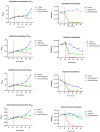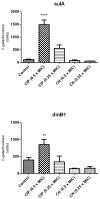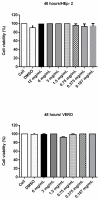New Insights into the Antimicrobial Action of Cinnamaldehyde towards Escherichia coli and Its Effects on Intestinal Colonization of Mice
- PMID: 33670478
- PMCID: PMC7922552
- DOI: 10.3390/biom11020302
New Insights into the Antimicrobial Action of Cinnamaldehyde towards Escherichia coli and Its Effects on Intestinal Colonization of Mice
Abstract
Escherichia coli is responsible for cases of diarrhea around the world, and some studies have shown the benefits of cinnamaldehyde in the treatment of bacterial disease. Therefore, the objective of this study was to evaluate the effects of cinnamaldehyde in mice colonized by pathogenic E. coli, as well as to provide more insights into its antimicrobial action mechanism. After determination of minimum inhibitory (MIC) and minimum bactericidal (MBC) concentrations, the interference of cinnamaldehyde in macromolecular pathways (synthesis of DNA, RNA, protein, and cell wall) was measured by incorporation of radioisotopes. The anti-adhesive properties of cinnamaldehyde towards E. coli 042 were evaluated using human epithelial type 2 (HEp-2) cells. Intestinal colonization was tested on mice, and the effect of cinnamaldehyde on Tenebrio molitor larvae. Cinnamaldehyde showed MIC and MBC values of 780 μg/mL and 1560 μg/mL, respectively; reduced the adhesion of E. coli 042 on HEp-2 cells; and affected all the synthetic pathways evaluated, suggesting that compost impairs the membrane/cell wall structure leading bacteria to total collapse. No effect on the expression of genes related to the SOS pathway (sulA and dinB1) was observed. The compound did not interfere with cell viability and was not toxic against T. molitor larvae. In addition, cinnamaldehyde-treated mice exhibited lower levels of colonization by E. coli 042 than the untreated group. Therefore, the results show that cinnamaldehyde is effective in treating the pathogenic E. coli strain 042 and confirm it as a promising lead molecule for the development of antimicrobial agents.
Keywords: cinnamaldehyde; intestinal colonization; natural products.
Conflict of interest statement
All authors: No reported conflicts.
Figures






Similar articles
-
Cinnamaldehyde: a compound with antimicrobial and synergistic activity against ESBL-producing quinolone-resistant pathogenic Enterobacteriaceae.Eur J Clin Microbiol Infect Dis. 2020 Jan;39(1):65-73. doi: 10.1007/s10096-019-03692-y. Epub 2019 Oct 17. Eur J Clin Microbiol Infect Dis. 2020. PMID: 31624984
-
Trans-cinnamaldehyde fumigation inhibits Escherichia coli by affecting the mechanism of intracellular biological macromolecules.Nat Prod Res. 2025 Jun;39(11):3160-3171. doi: 10.1080/14786419.2024.2331611. Epub 2024 Mar 22. Nat Prod Res. 2025. PMID: 38516726
-
The antimicrobial activities of the cinnamaldehyde adducts with amino acids.Int J Food Microbiol. 2011 Nov 1;150(2-3):164-70. doi: 10.1016/j.ijfoodmicro.2011.07.034. Epub 2011 Aug 4. Int J Food Microbiol. 2011. PMID: 21856030
-
Chemistry, Antimicrobial Mechanisms, and Antibiotic Activities of Cinnamaldehyde against Pathogenic Bacteria in Animal Feeds and Human Foods.J Agric Food Chem. 2017 Dec 6;65(48):10406-10423. doi: 10.1021/acs.jafc.7b04344. Epub 2017 Nov 20. J Agric Food Chem. 2017. PMID: 29155570 Review.
-
A review of cinnamaldehyde and its derivatives as antibacterial agents.Fitoterapia. 2019 Nov;139:104405. doi: 10.1016/j.fitote.2019.104405. Epub 2019 Nov 7. Fitoterapia. 2019. PMID: 31707126 Review.
Cited by
-
Phytochemicals: A Promising Weapon in the Arsenal against Antibiotic-Resistant Bacteria.Antibiotics (Basel). 2021 Aug 26;10(9):1044. doi: 10.3390/antibiotics10091044. Antibiotics (Basel). 2021. PMID: 34572626 Free PMC article. Review.
-
Bioactive Compounds from Plant Origin as Natural Antimicrobial Agents for the Treatment of Wound Infections.Int J Mol Sci. 2024 Feb 8;25(4):2100. doi: 10.3390/ijms25042100. Int J Mol Sci. 2024. PMID: 38396777 Free PMC article. Review.
-
Antimicrobial Efficacy of Cinnamon Essential Oil against Avian Pathogenic Escherichia coli from Poultry.Animals (Basel). 2023 Aug 16;13(16):2639. doi: 10.3390/ani13162639. Animals (Basel). 2023. PMID: 37627430 Free PMC article.
-
Antibacterial Effect of 16 Essential Oils and Modulation of mex Efflux Pumps Gene Expression on Multidrug-Resistant Pseudomonas aeruginosa Clinical Isolates: Is Cinnamon a Good Fighter?Antibiotics (Basel). 2023 Jan 12;12(1):163. doi: 10.3390/antibiotics12010163. Antibiotics (Basel). 2023. PMID: 36671364 Free PMC article.
-
Antibiofilm Activities of Cinnamaldehyde Analogs against Uropathogenic Escherichia coli and Staphylococcus aureus.Int J Mol Sci. 2022 Jun 29;23(13):7225. doi: 10.3390/ijms23137225. Int J Mol Sci. 2022. PMID: 35806244 Free PMC article.
References
-
- Taghadosi R., Shakibaie M.R., Hosseini-Nave H. Antibiotic resistance, ESBL genes, integrons, phylogenetic groups and MLVA profiles of Escherichia coli pathotypes isolated from patients with diarrhea and farm animals in south-east of Iran. Comp. Immunol. Microbiol. Infect. Dis. 2019;63:117–126. doi: 10.1016/j.cimid.2019.01.004. - DOI - PubMed
Publication types
MeSH terms
Substances
Grants and funding
LinkOut - more resources
Full Text Sources
Other Literature Sources

